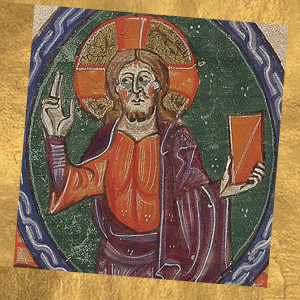St. Christopher, Martyr

Protector of travelers
The most popular image of St. Christopher depicts him as a huge, bearded man, carrying the Christ-Child on his shoulders as he wades across a river. The Child Jesus is holding the world in His hands like a ball. This image dates back to one of the most famous biographies of those who were martyred on July 25th in Samos, in Lycia. According to this tradition, Christopher’s real name was Reprobus and he was a giant of a man who wanted to be at the service of the world's strongest king. When he visited the court of a king who was apparently invincible, he entered his service. One day, while the king was listening to a song that mentioned the Devil, Reprobus saw him make the sign of the cross and asked him why he performed this gesture. The king replied that he was afraid of the Devil and that every time he heard him mentioned he made the sign of the cross for protection. Reprobus then decided to look for the Devil who was evidently more powerful than his king. The Devil proved easy enough to find and Reprobus chose to serve him. But one day, while passing through a street where there was a cross, the Devil retraced his steps to avoid it. Reprobus was curious why he did so and the Devil was forced to admit that Christ had died on a cross which was why the image terrified him. Reprobus then abandoned the Devil and went looking for Jesus Christ. A hermit advised him to build a hut near a river that flooded dangerously and to use his great strength and stature to assist travelers cross to the other side. One day he heard a child’s voice asking for help to cross the river. Reprobus put the child on his shoulders and began to wade through the rapidly rising water. But the further he went into the river, the heavier the child became. It was only with great effort that he managed to reach the opposite shore. There the child revealed his true identity as Jesus. The weight that Reprobus (now Christopher) had been carrying was that of the whole world, saved by the blood of Christ. This legend, in addition to inspiring western iconography, has made St Christopher patron of boatmen, pilgrims and travelers.
The saint with the dog's head
In the Eastern tradition, St. Christopher is occasionally depicted with a dog’s head, as can be seen from several icons kept in St. Petersburg and Sofia. According to some, the iconography of the Holy Cynocephalus, could stem from a cult born in a Hellenistic-Egyptian context, with a reference to the worship of the god Anubis. A more plausible, if complex, explanation could be the following: that Reprobus might have enlisted in the Roman army and converted to Christianity with the name of Christopher. Denounced for his religion and brought before a judge, he would have refused to recant and would have been decapitated. Christopher, therefore, would "carry Christ" in his heart until martyrdom, just like the donkey that carried Christ to Jerusalem on Palm Sunday. That is why, in the East, Christopher would have been depicted initially with a donkey’s head, which then would have evolved into a dog's head. The iconography is thus perfectly within the Christian tradition and is unrelated to pagan cults.
The eye protector
According to the Golden Legend, St Christopher's martyrdom took place in Samos, in Lycia. Tradition tells us that he resisted torture, inflicted with iron rods and burning metal. Arrows that were shot at him remained suspended in mid-air. One of them went back and blinded the king who had ordered the torture. Finally, they decided to decapitate Christopher. Before he died, however, Christopher told the king to dampen his wounded eye with the saint’s blood. The king did so and regained his sight immediately, subsequently converting to Christianity. Since then, St Christopher has been invoked to heal diseases of the eye.







